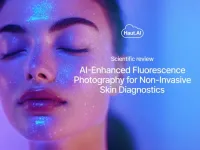(Press-News.org) PULLMAN, Wash. – A speed record has been broken using nanoscience, which could lead to a host of new advances, including improved battery charging, biosensing, soft robotics and neuromorphic computing.
Scientists at Washington State University and Lawrence Berkeley National Laboratory have discovered a way to make ions move more than ten times faster in mixed organic ion-electronic conductors. These conductors combine the advantages of the ion signaling used by many biological systems, including the human body, with the electron signaling used by computers.
The new development, detailed in the journal Advanced Materials, speeds up ion movement in these conductors by using molecules that attract and concentrate ions into a separate nanochannel creating a type of tiny “ion superhighway.”
“Being able to control these signals that life uses all the time in a way that we've never been able to do is pretty powerful,” said Brian Collins, WSU physicist and senior author on the study. “This acceleration could also have benefits for energy storage, which could be a big impact.”
These types of conductors hold a lot of potential because they allow movement of both ions and electrons at once, which is critical for battery charging and energy storage. They also power technologies that combine biological and electrical mechanisms, such as neuromorphic computing, which attempts to mimic thought patterns in the human brain and nervous system.
However, exactly how these conductors coordinate movement of both ions and electrons has not been well understood. As part of the investigations for this study, Collins and his colleagues observed that ions moved within the conductor relatively slowly. Because of their coordinated movement, the slow ion movement also slowed the electrical current.
“We found that the ions that were flowing all right in the conductor, but they had to go through this matrix, like a rat's nest of pipelines for electrons to flow. That was slowing down the ions,” Collins said.
To work around this problem, the researchers created a straight nanometer-sized channel just for the ions. Then, they had to attract the ions to it. For that they turned to biology. All living cells, including those in the human body, use ion channels to move compounds in and out of cells, so Collins’ team used a similar mechanism found in cells: molecules that love or hate water.
First, Collins’ team lined the channel with water-loving hydrophilic molecules which attracted the ions dissolved in water, also known as electrolyte. The ions then moved very quickly through channel—at speeds more than ten times faster than they would through water alone. The movement of ions represented a new world record for ion speed in any material.
Conversely, when the researchers lined the channel with hydrophobic, water-repelling, molecules, ions stayed away and were forced to travel through the slower “rat’s nest” instead.
Collins’ team found that chemical reactions could flip the molecules’ attractiveness to the electrolyte. This would open and close the ion superhighway, much the same way that biological systems control access through cell walls.
As part of their investigations, the team created a sensor that could quickly detect a chemical reaction near the channel because the reaction would open or close the ion superhighway creating an electrical pulse that a computer could read.
This detection ability on a nanoscale could help with sensing pollution in the environment, or neurons firing in the body and brain, which is one of many potential uses of the development, Collins said.
“The next step is really to learn all the fundamental mechanisms of how to control this ion movement and bring this new phenomenon to technology in a variety of ways,” he said.
This study was supported by the National Science Foundation. In addition to Collins, researchers on this study include first author Tamanna Khan, co-authors Thomas Ferron and Awwad Alotaibi of WSU as well as Terry McAfee of Lawrence Berkeley National Laboratory.
END
New ion speed record holds potential for faster battery charging, biosensing
2024-11-19
ELSE PRESS RELEASES FROM THIS DATE:
Haut.AI explores the potential of AI-enhanced fluorescence photography for non-invasive skin diagnostics
2024-11-19
Tallinn, Estonia – 19th November 2024, 10 AM CET – Haut.AI, a pioneering artificial intelligence (AI) company for skincare and beauty applications, has published an exciting scientific review—one that explores state-of-the-art developments in skin fluorescence photography and its applications, focusing on combining it with AI algorithms for non-invasive skin diagnostics. The study highlights the power of AI to enhance skin fluorescence photography, allowing early, non-invasive detection of skin conditions. This approach allows skincare experts to diagnose underlying issues ...
7-year study reveals plastic fragments from all over the globe are rising rapidly in the North Pacific Garbage Patch
2024-11-19
A study published today in IOP Publishing’s journal Environmental Research Letters reveals that centimetre-sized plastic fragments are increasing much faster than larger floating plastics in the North Pacific Garbage Patch [NPGP], threatening the local ecosystem and potentially the global carbon cycle.
The research, which draws from not-for-profit The Ocean Cleanup’s systematic surveys of the NPGP between 2015 and 2022, found an unexpected rise in mass concentration of plastic fragments that are ...
New theory reveals the shape of a single photon
2024-11-19
A new theory, that explains how light and matter interact at the quantum level has enabled researchers to define for the first time the precise shape of a single photon.
Research at the University of Birmingham, published in Physical Review Letters, explores the nature of photons (individual particles of light) in unprecedented detail to show how they are emitted by atoms or molecules and shaped by their environment.
The nature of this interaction leads to infinite possibilities for light to exist and propagate, or travel, through its surrounding environment. This limitless ...
We could soon use AI to detect brain tumors
2024-11-19
A new paper in Biology Methods and Protocols, published by Oxford University Press, shows that scientists can train artificial intelligence models to distinguish brain tumors from healthy tissue. AI models can already find brain tumors in MRI images almost as well as a human radiologist.
Researchers have made sustained progress in artificial intelligence (AI) for use in medicine. AI is particularly promising in radiology, where waiting for technicians to process medical images can delay patient treatment. Convolutional neural networks are powerful tools that allow researchers to train AI models on large image datasets to recognize ...
TAMEST recognizes Lyda Hill and Lyda Hill Philanthropies with Kay Bailey Hutchison Distinguished Service Award
2024-11-19
TAMEST is pleased to announce Lyda Hill and Lyda Hill Philanthropies as the recipients of the Kay Bailey Hutchison Distinguished Service Award.
TAMEST is recognizing Lyda Hill and her team for empowering and enabling groundbreaking research in science and nature that profoundly impacts society. Lyda Hill, a successful businesswoman and world-renowned philanthropist, believes science can solve many of the world’s most challenging issues and has chosen to donate all of her estate to philanthropy and scientific research.
Aligned with this mission, Lyda Hill is committed to advancing science and public ...
Establishment of an immortalized red river hog blood-derived macrophage cell line
2024-11-19
Red river hogs (RRHs) (Potamochoerus porcus), a wild species of Suidae living in Africa, have grabbed much attention as an animal that harbors African swine fever virus (ASFV) as natural hosts. When ASFV infects domestic pigs and wild boars, it proliferates within macrophages, a type of immune cells, and infected pigs rapidly die suffering from symptoms such as fever and hemorrhage. On the other hand, ASFV infection in RRHs is asymptomatic and does not cause death, suggesting that RRH macrophages may have a protective mechanism against ASFV infection.
In vitro cell cultures of porcine macrophages are generally ...
Neural networks: You might not need to buy every ticket to win the lottery
2024-11-19
The more lottery tickets you buy, the higher your chances of winning, but spending more than you win is obviously not a wise strategy. Something similar happens in AI powered by deep learning: we know that the larger a neural network is (i.e., the more parameters it has), the better it can learn the task we set for it. However, the strategy of making it infinitely large during training is not only impossible but also extremely inefficient. Scientists have tried to imitate the way biological brains learn, which is highly resource-efficient, by providing machines with a gradual training process that starts with ...
Healthy New Town: Revitalizing neighborhoods in the wake of aging populations
2024-11-19
Planned suburban residential neighborhoods in metropolitan areas known as new towns were initially developed in England. The new town movement spread from Europe to East Asia, such as to Japan, South Korea, Hong Kong, and Singapore. In Japan alone, 2,903 New Towns were built, but many experienced rapid population decline and aging in the 40 years after their development. Therefore, they changed into old new towns and had to transform their facilities.
Dr. Haruka Kato, a junior associate professor at Osaka Metropolitan ...
High exposure to everyday chemicals linked to asthma risk in children
2024-11-19
A new study from researchers at Kumamoto University sheds light on a potential link between exposure to certain everyday chemicals during pregnancy and the development of asthma in children. The study analyzed data from over 3,500 mother-child pairs as part of the Japan Environment and Children’s Study (JECS), a large-scale nationwide research project.
Key Findings:
High levels of butylparaben, a chemical commonly used in personal care products like lotions and shampoos, during early pregnancy were associated with a 1.54-fold increase in the odds of asthma development in children ...
How can brands address growing consumer scepticism?
2024-11-19
Transparency and effective communication are critical for brands to gain and keep consumer trust according to new research.
The University of Adelaide’s Dr Kate Sansome, from the Adelaide Business School has led a study which suggests that consumers want brands to be transparent about topics that impact them.
“As sociopolitical issues become topical in the news and social media, brands are expected to be transparent about them; for example, as consumers face cost-of-living pressures, they will expect brands to be transparent about this issue,” says Dr Sansome, who conducted the study with the Professor Jodie Conduit and Dr ...










